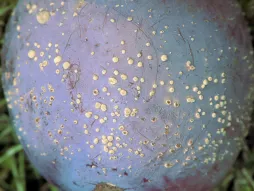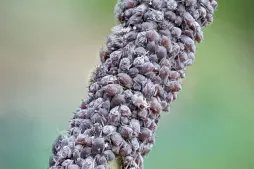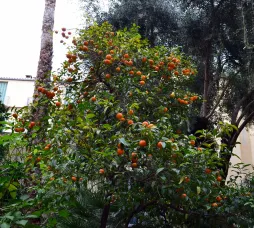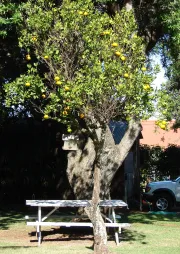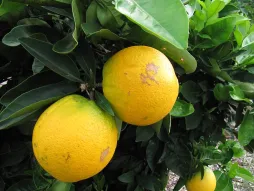Citrus × aurantium f. aurantium, the bitter orange tree
Hybridization of Citrus maxima and Citrus reticulata (Citrus. Maxima × C. Reticulata) gives rise to Citrus x aurantium f. Aurantium. This tree, native to China and also known as the bitter orange tree, is distinguished by its distinctive fruit flavors and sweet-smelling blossoms.
How to recognize Citrus aurantium, the bitter orange tree?
An upright or bushy tree, Citrus x aurantium f aurantium reaches a height of fifteen meters for a spread of three in its natural environment. In our latitudes, it grows to no more than three meters in height in pots.
The dark-green, fragrant foliage lasts all year round. The oval leaves are up to fourteen centimetres long. Some have a thorn at the base of the petiole.
Flowers bloom singly or in groups of two or three. White or pink, they give off a suave scent that is less sweet than that of other citrus fruits, such as citrus bergamia (Citrus bergamia).
The round, slightly flattened fruits are covered with an irregular orange-yellow rind. The flesh is not very juicy, bitter and rich in seeds.
Citrus × aurantium f. Aurantium is non-toxic, and its fruit, the bitter orange, is used to make jams, marmalades and drinks. But it's not the only part of the plant that's exploited. From the flowers are extracted orange blossom absolute, orange blossom water and neroli essence, three substances widely used in perfumery.
Our maintenance tips
Maintaining a Citrus × aurantium f. Aurantium is not difficult. Above all, you need to protect it from frost in winter and provide it with the nutrients it needs to grow. With the right potting soil and regular fertilizing, you'll soon be enjoying your own citrus fruits.
Bitter orange trees citrus trees need regular watering all year round. During hot spells, water early in the morning or in the evening. Water evaporates less quickly, and your shrub benefits from it for longer.
Watering
Bitter orange trees like to keep their feet cool, but can't stand soggy soil. Water when the substrate is dry on the surface, for about three centimetres.
To provide your plant with the nutrients it needs, give preference to rainwater. Avoid tap water, which is often too hard. Finally, to avoid damaging the roots, use water at room temperature.
If you use a saucer or planter, remove any stagnant water. It could rot the root system.
Repotting
Every spring, repot your Citrus × aurantium f. Aurantium to give it more space.
When roots protrude from the pot or are visible on the surface, it's time to repot!
To prepare your Citrus × aurantium f. Aurantium for repotting, soak the root ball. Then gently loosen the root ball.
Choose a terracotta pot or a wooden tub. Both materials encourage water evaporation and reduce the risk of over-watering. Make sure the container is perforated to allow water to drain away.
At the bottom, place a bed of clay balls or gravel to facilitate drainage.
Top up with a rich substrate, such as special citrus or planting soil. You can make your own mixture with :
- one-third planting soil
- one-third garden soil
- pozzolan.
Place your shrub in the center. The surface of the rootball should be two centimetres below the rim of the pot. Fill with substrate and tamp to eliminate air bubbles. When planting, do not bury the collar.
Fertilization
To promote the growth of your Citrus × aurantium f. Aurantium, apply fertilizer in spring and summer.
Bitter orange trees are greedy plants. They need to be fertilized. Feed yours with a special liquid or granulated citrus fertilizer.
Cleaning
Dust on the leaves slows down photosynthesis and hinders your plant's growth. Clean foliage with a clean, damp sponge. This operation also helps prevent invasions by mites and other pests.
Harvest
Harvesting takes place when the fruit has taken on its final color and can be easily detached from the branch.
Prune
Size is not essential. It only helps to control shape and development and improves fruiting. When pruning, always use clean, sharp pruning shears.
Citrus trees flower and fruit on the year's wood. To maintain the compact, rounded shape of your shrub, remove dead branches and shoots growing along the trunk. You can also aerate the center by removing some shoots that have already borne fruit in previous years.
If you want to improve your harvest, you can also carry out a fruiting pruning operation: one month after the appearance of a new shoot, prune it back to a height of 20 centimetres.
Pinch
Pinch your Citrus × aurantium f. Aurantium during its growing season.
Pinch stem ends to optimize branching and maintain a compact habit.
Plantation
When the risk of frost has passed, it's time to plant.
Find them a place sheltered from the wind and isolated from other plants. Citrus plants have shallow roots and don't like to share their space.
Dig a hole 70 centimetres wide and 1 metre in diameter. While you're at it, soak the root ball.
Plant the plant in the middle, with the top of the rootball level with the ground. Take care not to bury the collar.
Bitter orange trees plants thrive in light, well-drained, rich soil. When filling in, add potting soil or citrus soil to your garden soil. Tamp and water.
Diseases / Threats
Information
| Family | Rutaceae - Rutaceae |
| Type | Citrus - Citrus |
| Species | Citrus × aurantium - Citrus × aurantium |
| Lifecycle | Perennial |
| Foliage | Evergreen |
| Exposures | |
| Substrat | |
| Planting methods |
Open ground In pots In tubs |
| Categories | |
| Tags |
Edible fruit Flowery Fritillary |
| Origin |
East Asia |
| Hardiness (USDA) | 9a |
| Leaf color |
|
| Flower colors |
|
| Fruit colors |
|
Discover plants from the same family
















